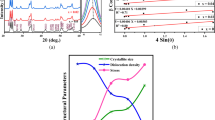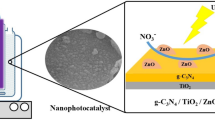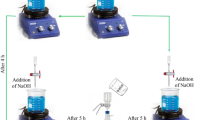Abstract
Oxide semi-conductors such as TiO2, ZnO, CuO have been extensively studied for long time for its photocatalytic activity and its application in waste water treatment. These semiconductors on excitation with UV or visible light generate e−-h+ pairs that react with O2 / H2O respectively to produce Reactive Oxygen Species (ROS) such as O2−•, •OH radicals. These ROS degrade the contaminants in water. There is a need for catalysts that produce these ROS even in absence of light (dark) and such Day-Night catalysts are significant from the point of view of 24 × 7 operation. Towards this objective, Na doped CuO, Cu1−xNaxO (x = 0 to 0.1) has been synthesized, characterized by X-ray diffraction (XRD), Transmission electron microscopy (TEM), X-Ray photoelectron spectroscopy (XPS) and Ultra violet visible-diffuse reflectance spectroscopy (UV-DRS). The particle size of Cu1−xNaxO is in the range of 25 to 75 nm. Its photocatalytic activity has been reported for the first time. These compositions exhibit Photocatalytic activity in dark (in absence of light) too and is attributed to super oxide species generated due to vacancies created esp in Na doped compositions. Hence, the Na doped CuO acts as Day-Night catalysts and the rates of degradation are higher than those reported earlier for CuO. Reactive Oxygen Species (ROS) liberated from its aqueous suspensions have been estimated and correlated to its activity.
















Similar content being viewed by others
Data availability
The authors confirm that the data supporting the finding of this study are available within the article and its supplementary materials. Moreover, the raw data are available from the corresponding authors (VR) upon reasonable request.
References:
Wang ZL (2003) Nanobelts, nanowires, and nanodiskettes of semiconducting oxides - From materials to nanodevices. Adv Mater 15:432–436. https://doi.org/10.1002/adma.200390100
Fergus JW (2007) Perovskite oxides for semiconductor-based gas sensors. Sensors Actuators B Chem 123:1169–1179. https://doi.org/10.1016/j.snb.2006.10.051
Iijima S (1991) Helical microtubules of graphitic carbon. Nature 354:737–740. https://doi.org/10.1038/354056a0
Dietl T (2010) A ten-year perspective on dilute magnetic semiconductors and oxides. Nat Mater 9:965–974. https://doi.org/10.1038/nmat2898
Nomura K, Ohta H, Takagi A et al (2004) Room-temperature fabrication of transparent flexible thin-film transistors using amorphous oxide semiconductors. Nature 432:488–492. https://doi.org/10.1038/nature03090
Ng C, Fan W (2007) Facile synthesis of single-crystalline y-cul nanotetrahedrons and their induced transformation to tetrahedral CuO nanocages. J Phys Chem C 111:9166–9171. https://doi.org/10.1021/jp071773d
Gao XP, Bao JL, Pan GL et al (2004) Preparation and electrochemical performance of polycrystalline and single crystalline CuO nanorods as anode materials for Li ion battery. J Phys Chem B 108:5547–5551. https://doi.org/10.1021/jp037075k
Singh DP, Ojha AK, Srivastava ON (2009) Synthesis of different Cu(OH)2 and CuO (nanowires, rectangles, seed-, belt-, and sheetlike) nanostructures by simple wet chemical route. J Phys Chem C 113:3409–3418. https://doi.org/10.1021/jp804832g
Taubert A, Uhlmann A, Hedderich A, Kirchhoff K (2008) CuO particles from ionic liquid/water mixtures: Evidence for growth via Cu(OH)2 nanorod assembly and fusion. Inorg Chem 47:10758–10764. https://doi.org/10.1021/ic801335k
Wang W, Tade MO, Shao Z (2018) Nitrogen-doped simple and complex oxides for photocatalysis: A review. Prog Mater Sci 92:33–63. https://doi.org/10.1016/j.pmatsci.2017.09.002
Marschall R, Wang L (2014) Non-metal doping of transition metal oxides for visible-light photocatalysis. Catal Today 225:111–135. https://doi.org/10.1016/j.cattod.2013.10.088
Chen D, Cheng Y, Zhou N et al (2020) Photocatalytic degradation of organic pollutants using TiO2-based photocatalysts: A review. J Clean Prod 268:121725. https://doi.org/10.1016/j.jclepro.2020.121725
Lee KM, Lai CW, Ngai KS, Juan JC (2016) Recent developments of zinc oxide based photocatalyst in water treatment technology: A review. Water Res 88:428–448. https://doi.org/10.1016/j.watres.2015.09.045
Sibhatu AK, Weldegebrieal GK, Sagadevan S et al (2022) Photocatalytic activity of CuO nanoparticles for organic and inorganic pollutants removal in wastewater remediation. Chemosphere 300:134623. https://doi.org/10.1016/j.chemosphere.2022.134623
Ramesh M (2021) CuO as efficient photo catalyst for photocatalytic decoloration of wastewater containing Azo dyes. Water Pract Technol 16:1078–1090. https://doi.org/10.2166/wpt.2021.067
Raizada P, Sudhaik A, Patial S et al (2020) Engineering nanostructures of CuO-based photocatalysts for water treatment: Current progress and future challenges. Arab J Chem 13:8424–8457. https://doi.org/10.1016/j.arabjc.2020.06.031
Rao MP, Wu JJ, Asiri AM et al (2018) Photocatalytic properties of hierarchical CuO nanosheets synthesized by a solution phase method. J Environ Sci (China) 69:115–124. https://doi.org/10.1016/j.jes.2017.05.005
Nazim M, Khan AAP, Asiri AM et al (2021) Exploring Rapid Photocatalytic Degradation of Organic Pollutants with Porous CuO Nanosheets: Synthesis, Dye Removal, and Kinetic Studies at Room Temperature. ACS Omega 6:2601–2612. https://doi.org/10.1021/acsomega.0c04747
Anandan S, Yang S (2007) Emergent methods to synthesize and characterize semiconductor CuO nanoparticles with various morphologies - An overview. J Exp Nanosci 2:23–56. https://doi.org/10.1080/17458080601094421
Wu H, Zhang L, Du A et al (2022) Low-bias photoelectrochemical water splitting via mediating trap states and small polaron hopping. Nat Commun 13:1–12. https://doi.org/10.1038/s41467-022-33905-6
Wu H, Irani R, Zhang K et al (2021) Unveiling Carrier Dynamics in Periodic Porous BiVO4 Photocatalyst for Enhanced Solar Water Splitting. ACS Energy Lett 6:3400–3407. https://doi.org/10.1021/acsenergylett.1c01454
Wu H, Zheng Z, Toe C et al (2020) A pulse electrodeposited amorphous tunnel layer stabilises Cu2O for efficient photoelectrochemical water splitting under visible-light irradiation. J Mater Chem A 8:5638–5646. https://doi.org/10.1039/d0ta00629g
Mishra SR, Ahmaruzzaman M (2022) CuO and CuO-based nanocomposites: Synthesis and applications in environment and energy. Sustain Mater Technol 33:e00463. https://doi.org/10.1016/j.susmat.2022.e00463
Lakshmi Prasanna V, Vijayaraghavan R (2015) Insight into the Mechanism of Antibacterial Activity of ZnO: Surface Defects Mediated Reactive Oxygen Species even in the Dark. Langmuir 31:9155–9162. https://doi.org/10.1021/acs.langmuir.5b02266
Biswas A, Kar U, Jana NR (2022) Cytotoxicity of ZnO nanoparticles under dark conditions via oxygen vacancy dependent reactive oxygen species generation. Phys Chem Chem Phys 24:13965–13975. https://doi.org/10.1039/d2cp00301e
Hou C, Hu B, Zhu J (2018) Photocatalytic degradation of methylene blue over TiO2 pretreated with varying concentrations of NaOH. Catalysts 8(12). https://doi.org/10.3390/catal8120575
Siddiqui H, Parra MR, Qureshi MS et al (2018) Studies of structural, optical, and electrical properties associated with defects in sodium-doped copper oxide (CuO/Na) nanostructures. J Mater Sci 53:8826–8843. https://doi.org/10.1007/s10853-018-2179-6
Siddiqui H, Qureshi MS, Haque FZ (2020) Alkali metals doped Cu0.95X0.05O (x = Li, Na and K) nanoparticles: Facile synthesis, structural, optical properties and solar cell application. Mater Lett 275:128090. https://doi.org/10.1016/j.matlet.2020.128090
Priscilla SJ, Sivaji K, Vimaladevi L (2017) Synthesis and characterization of Na doped cupric oxide (CuO) nanoparticles. AIP Conf Proc 1832. https://doi.org/10.1063/1.4980361
Kanai H, Mizusaki J, Tagawa H et al (1997) Defect Chemistry of La2−xSrxCuO4−δ: Oxygen Nonstoichiometry and Thermodynamic Stability. J Solid State Chem 159(1):150–159. https://doi.org/10.1006/jssc.1997.7377
Xu Y, Schoonen MA (2000) The absolute energy positions of conduction and valence bands of selected semiconducting minerals. Am. Mineral 85(3):543–556. https://doi.org/10.2138/am-2000-0416
Kim KJ, Kreider PB, Choi C et al (2013) Visible-light-sensitive Na-doped p-type flower-like ZnO photocatalysts synthesized via a continuous flow microreactor. RSC Adv 3(31):12702–12710. https://doi.org/10.1039/c3ra41866a
Gupta SV, Kulkarni VV, Ahmaruzzaman M (2023) Bandgap engineering approach for designing CuO/Mn3O4/CeO2 heterojunction as a novel photocatalyst for AOP-assisted degradation of Malachite green dye. Sci Rep 13:1–21. https://doi.org/10.1038/s41598-023-30096-y
Lv J, Huang K, Chen X et al (2011) Optical constants of Na-doped ZnO thin films by sol-gel method. Opt Commun 284:2905–2908. https://doi.org/10.1016/j.optcom.2011.01.075
Lakshmi Prasanna V, Rajagopalan V (2016) A New Synergetic Nanocomposite for Dye Degradation in Dark and Light. Sci Rep 6:1–10. https://doi.org/10.1038/srep38606
Wang X, Yang J, Shi L, Gao M (2016) Surfactant-free Synthesis of CuO with Controllable Morphologies and Enhanced Photocatalytic Property. Nanoscale Res Lett 11. https://doi.org/10.1186/s11671-016-1278-z
Zaman S, Zainelabdin A, Amin G et al (2012) Efficient catalytic effect of CuO nanostructures on the degradation of organic dyes. J Phys Chem Solids 73:1320–1325. https://doi.org/10.1016/j.jpcs.2012.07.005
Sadollahkhani A, Hussain Ibupoto Z, Elhag S et al (2014) Photocatalytic properties of different morphologies of CuO for the degradation of Congo red organic dye. Ceram Int 40:11311–11317. https://doi.org/10.1016/j.ceramint.2014.03.132
Yang M, He J (2011) Fine tuning of the morphology of copper oxide nanostructures and their application in ambient degradation of methylene blue. J Colloid Interface Sci 355:15–22. https://doi.org/10.1016/j.jcis.2010.11.022
Azeez F, Al-Hetalani E, Arafa M et al (2018) The effect of surface charge on photocatalytic degradation of methylene blue dye using chargeable titania nanoparticles. Sci Rep 8:1–9. https://doi.org/10.1038/s41598-018-25673-5
Tabib A, Bouslama W, Sieber B et al (2017) Structural and optical properties of Na doped ZnO nanocrystals: Application to solar photocatalysis. Appl Surf Sci 396:1528–1538. https://doi.org/10.1016/j.apsusc.2016.11.204
Joe A, Park S, Shim K et al (2017) Antibacterial mechanism of ZnO nanoparticles under dark conditions. J Ind Eng Chem 45:430–439. https://doi.org/10.1016/j.jiec.2016.10.013
Acknowledgements
Authors thank VIT- Seed Grant 2022-23 for funding.
Author information
Authors and Affiliations
Contributions
Mittal Bathwar: Data correction, Validation, Methodology, original draft.
Vijayaraghavan R: Review & editing, Supervision, funding acquisition.
Corresponding author
Ethics declarations
Conflicts of interest
The authors declare no competing interest.
Additional information
Publisher's note
Springer Nature remains neutral with regard to jurisdictional claims in published maps and institutional affiliations.
Supplementary Information
Below is the link to the electronic supplementary material.
Rights and permissions
Springer Nature or its licensor (e.g. a society or other partner) holds exclusive rights to this article under a publishing agreement with the author(s) or other rightsholder(s); author self-archiving of the accepted manuscript version of this article is solely governed by the terms of such publishing agreement and applicable law.
About this article
Cite this article
Bathwar, M., R, V. Na doped CuO as a new Day- Night (Photo) Catalyst. J Nanopart Res 25, 142 (2023). https://doi.org/10.1007/s11051-023-05801-7
Received:
Accepted:
Published:
DOI: https://doi.org/10.1007/s11051-023-05801-7




